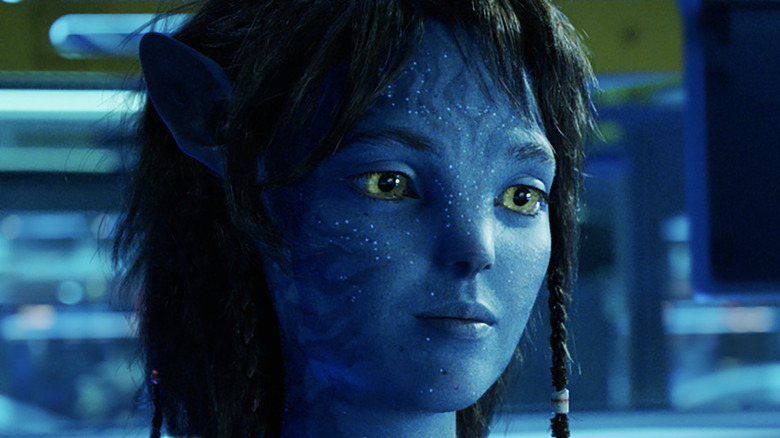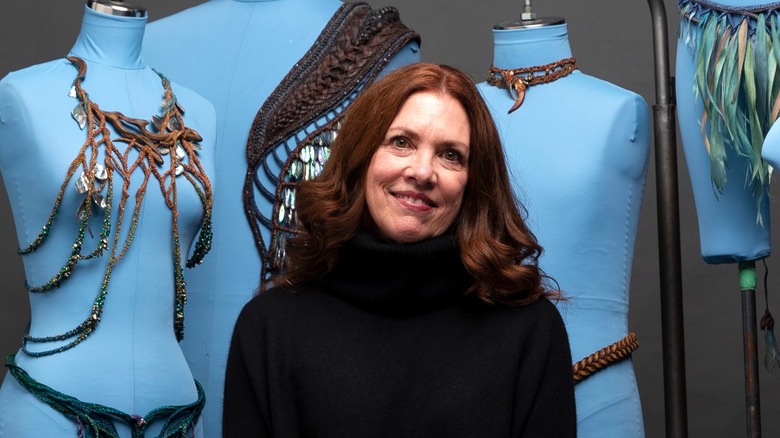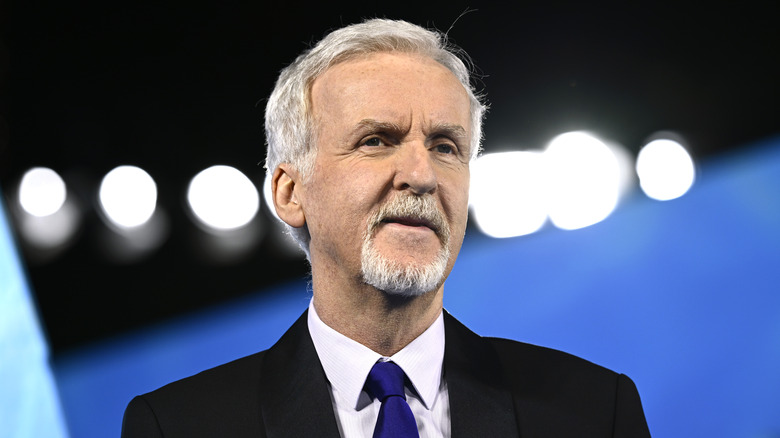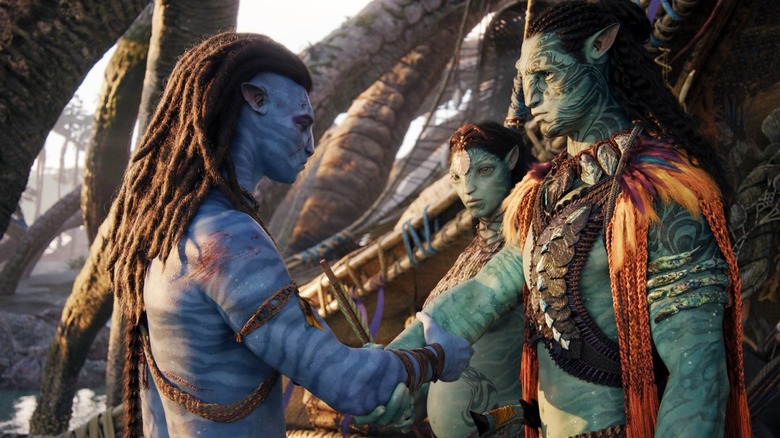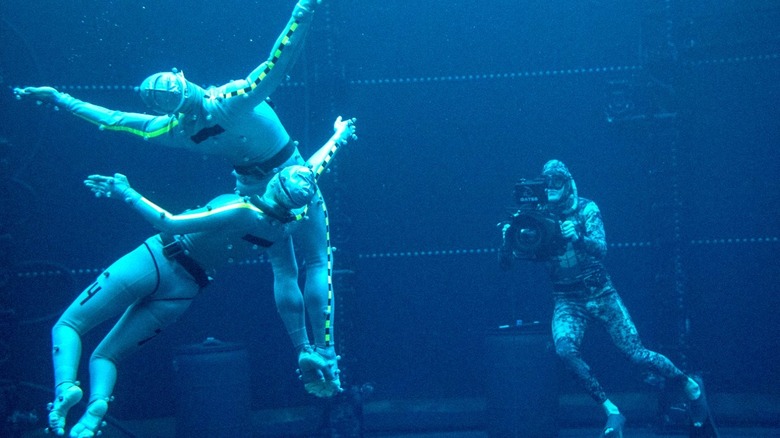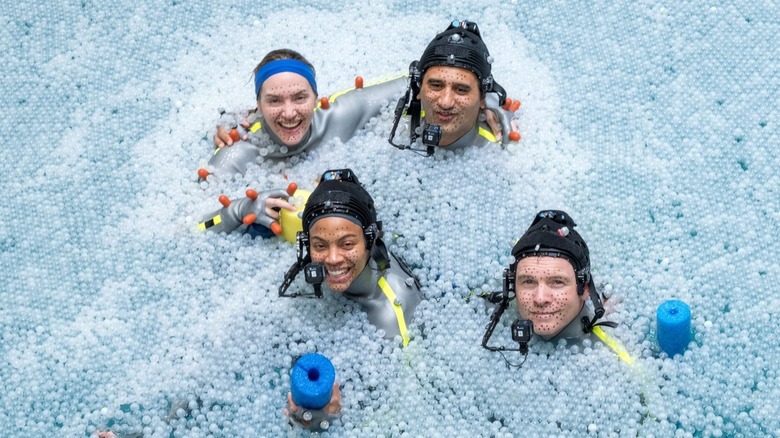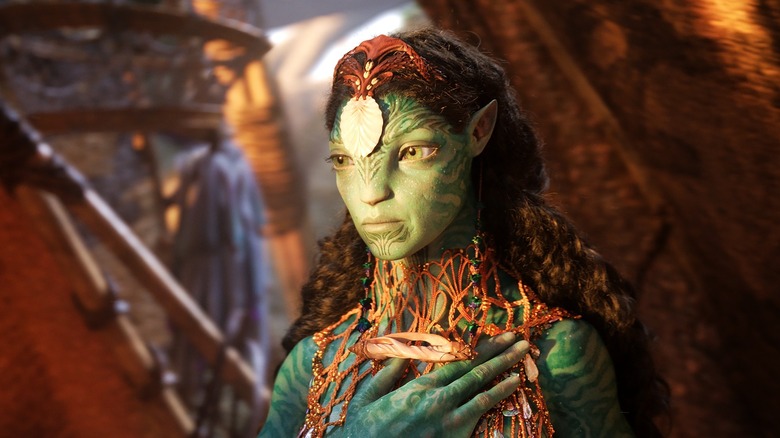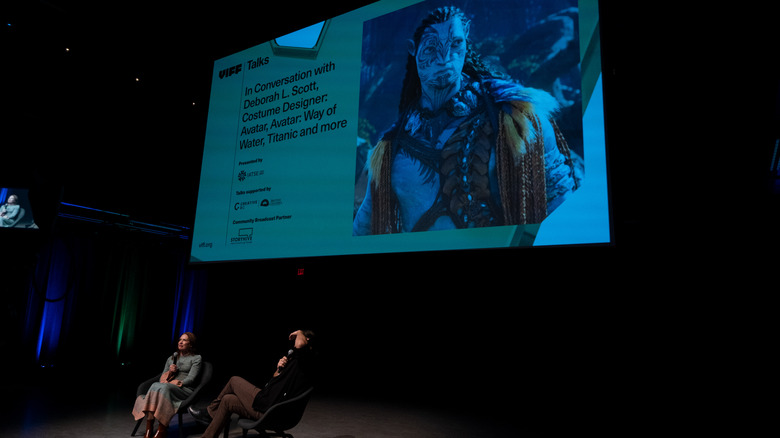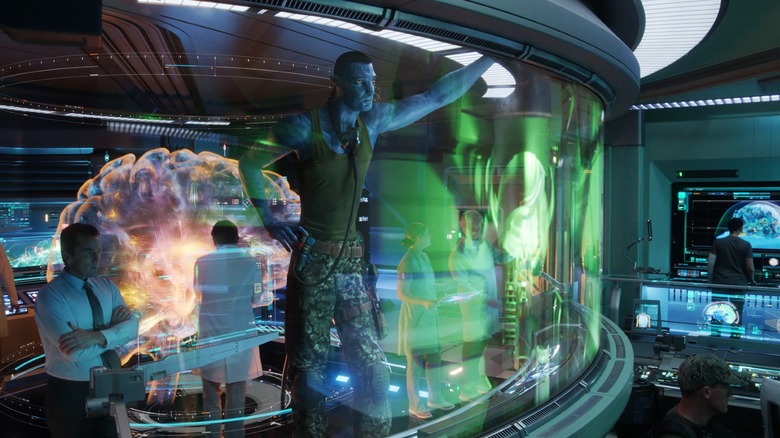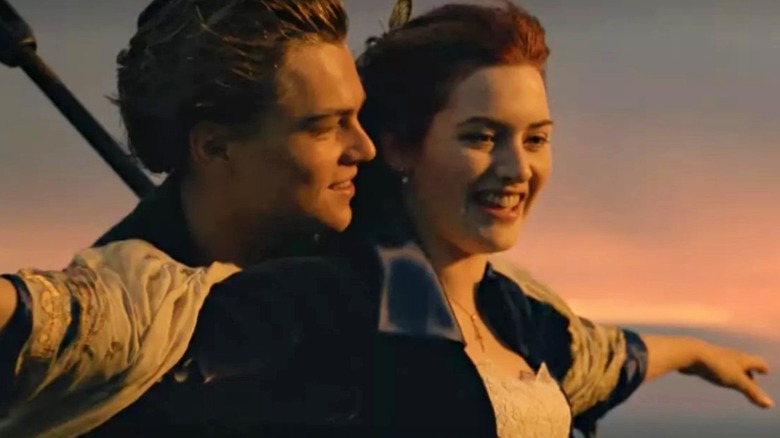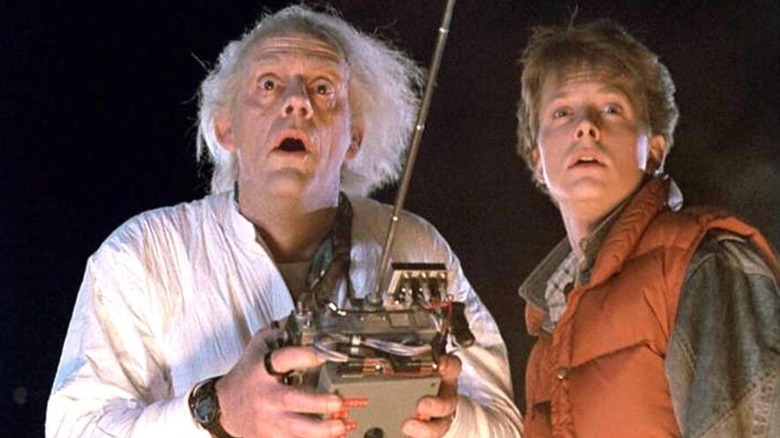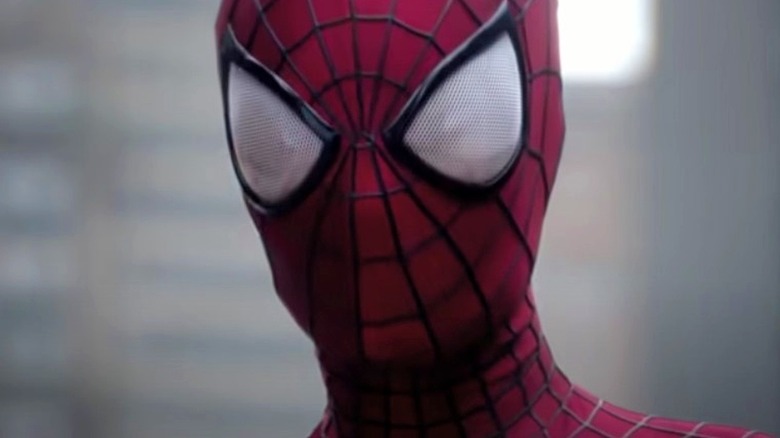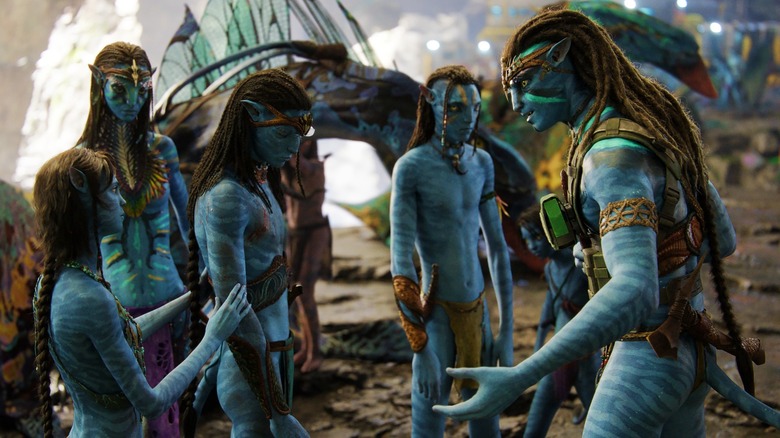Avatar: The Way Of Water Costume Designer Deborah L. Scott On Returning To Pandora With James Cameron - Exclusive Interview
Academy Award-winning costume designer Deborah L. Scott has built a stellar career for herself in Hollywood over the past four decades, working in the costume department for such classics as "E.T. the Extraterrestrial" and designing the iconic duds for the beloved sci-fi comedy "Back to the Future." Yet while Scott has worked with her share of legendary directors since she broke into the business, the costumes she's designed for Oscar-winning writer-director James Cameron have undoubtedly taken her gift for tailoring to a whole new level.
Kicking off her longtime collaborative partnership with Cameron on his 1997 worldwide blockbuster "Titanic" — which earned Scott an Oscar for best costume design — the sartorial visionary reteamed with the filmmaker to design the costumes for the 2009 global smash "Avatar." Now, 13 years after the release of the original film, Scott is back as the costume designer for "Avatar: The Way of Water," where she works again with Sam Worthington, Zoe Saldaña, Stephen Lang, and Sigourney Weaver. The film also pairs Scott in the performance capture realm with Cliff Curtis and Kate Winslet, the latter of whom worked closely with the acclaimed costumer on "Titanic."
In an exclusive interview with Looper, Scott discussed her longtime partnership with Cameron and the complex process of designing costumes for performance capture portrayals in the "Avatar" films, and she took a look back at her work on "Titanic" as the film celebrates the 25th anniversary of its release.
Voyaging back to Pandora
Since "Avatar: The Way of Water" has been a long time coming, I would imagine you were sitting there thinking, "James [Cameron] wants me to do the costumes, but when?" At what point did you get involved in the process?
On this particular one, I started approximately eight months before we started performance capture, and then live-action followed that. I had probably about a year and a half real prep, but then you're still designing and doing everything you need to do for the virtual world for quite a while. [It was] probably a total of two years or two and a half. It's a long time.
But Jim didn't slack off. He was doing other things, and then he decided to write the script and wanted the script, and then it was a bunch of scripts. He was quite busy, and they were developing the production design and the world a little bit before that, and when I joined in, we hit the ground running.
A passionate filmmaker
James Cameron first contacted you for doing the costumes for "Titanic," and nearly a dozen years later, "Avatar." It seems to me that he has this family of creatives, and once you join that family, you're always part of that family. Would that be true?
I think so. It's like any collaborator — you want to find the people that you have a shorthand with, eventually. You don't want to each time start anew. When I came in on the first "Avatar," it became clear to him the parameters that he wanted the costumes to take, and the fact that we needed to build every single digital costume.
It's like reading any texture map — you can't read it unless it's real. The clothing is quite complex. It's got a lot of layers. It's a 3D map that we handed them. When you get to that place, it was an easy go-to after "Avatar" to hire me for "Avatar 2." It was nice to be back. It took a while — it was a few years — but it was nice to be back and immerse myself in the world with him.
I interviewed James twice for the first "Avatar" in 2009, and the word I would say that defines him after those conversations is "passion." What word would you pick to describe him?
He's definitely passionate. I also think that — everyone says it, and it sounds trite — but he's a genius. He really is. He has an incredible imagination ... He relies on a lot of his technical abilities because he's so smart and he's done so much, and he's been an inventor, and he's been all these things. But he's very much of an artistic genius as well, and his imagination is absolutely boundless. He sets the bar so high for all of us, all the crew, and he supports us to get to that level.
Making every design real
Once you start working on his films, are you on James' speed dial? How frequently do you talk between the time you joined the new "Avatar" and now?
It's incredibly busy from the time I started — which has been five and a half years, because we were working on film three concurrently [with "Avatar 2"]. When we shot a lot of the performance capture, we had all the design time [and] all the research time that backed that up. [We had to do] the research of the designs so that we could proof of concept — that they would work — especially in the water.
When you shoot performance capture for so long, you need to make sure that the actors know if they interact with their clothing. They have to know what they're touching. It's not like a T-shirt; the costumes are more complex, so if they need to hold their shawl or whatever, they need to have those reference pieces. We did an immense amount of visual research in water with different materials, which led me to be able to figure out which materials sometimes to use for specific costumes. Plus, we manufactured every single costume. Every single Naʼvi costume was made — front, back, and center, every bit of it, so that takes a long time.
It's about 200 hours, probably, per garment. I had an incredible team at Weta Workshop [to do that] for the most part and a few people in Los Angeles.
Diving into a new method of performance capture
How has designing for motion capture changed since the first film? Since technology has grown since then, I would imagine that there has to be some difference.
Right. Well, the capture specifically, we call it "performance capture" now — that's Jim's term for it. Because it does. The facial capture is so much more evolved. That's the first thing. But the ability — the suits for the live stage — are a little bit more complex. We do markers on fingers and toes and things like that, because most of these people are barefoot. You have to capture the articulation of their feet, so that gets a little tricky.
We did the same thing in the tank. We had to develop [that technology], because no one had ever shot performance capture literally underwater before. As they were developing the technology of the markers, I was developing how to put it together in a suit for the divers and the actors to be comfortable ... it was very complicated. Since the digital world has advanced, I knew that the costumes had to meet that level. They were going to be able to read every bead and every knot [on the costumes]. It gave me this freedom to make the costumes as complex or simple as I wanted.
Scott closely collaborates with the performance capture actors
How much collaboration was there between you and the performance capture actors? Do they work with the real costumes that you make to help inform what they're doing in performance capture?
Quite often they do. Sometimes it's only gotten to a design, like a 2D design. But Jim — every time an actor or a new person would come in — he gave them the whole lowdown. He would be like, "Here are the designs, here's what your characters look like and the things they might wear." Then we would give them reference costumes for the stage that didn't include markers that they could use: capes and ponchos and things like that, with weird holes cut in them. He would put them on a pretend Ikran [mountain banshee] with huge Ritter fans blowing in their face to see how everything moved around them.
Then actors like Sigourney [Weaver] — her character is a kind of collector; she's a seer — would often visit what I would call my office, which is my showroom. Sigourney would wander around and pick things up. She's very tactile and very interested in what those pieces would mean to her.
People have all sorts of [different approaches]. Stephen Lang is a very cool guy, helped design the [military] unit patch — Project Deja Blue — with me. We had a lot of fun with that, and Jim was really involved in that, too. Usually, there's an abstraction between performance capture and costumes, but we were all together all the time if they needed to know what they were wearing in a certain scene. Kate Winslet would come in, for example, and when you first see her in the movie, she sashays down a walkway with a skirt. I made a skirt of fronds for her so she could feel what that felt like, because that helped her get that motion.
A reunion 25 years in the making
How wonderful was it to reunite with Kate Winslet? Maybe you saw her in between, but it must have been a cool feeling knowing it was 25 years ago you worked together on "Titanic" before seeing her again with "Avatar: The Way of Water."
We hadn't seen each other [since "Titanic"], so the day she arrived, it was the most incredible feeling of like, "Oh my gosh, you're here." After all those years and two Jim Cameron films — which are very strenuous, to say the least — it was wonderful. We had the best time. It was as if no time passed.
That's the wonderful thing about the film business, too. It's like no time passes sometimes when you see an actor or a director or another crew member. You're like, "Oh my gosh, you remember that? Remember that day? Remember how we did that?"
It was really fun. She's wonderful. She's wonderful in the movie. She was, again, wonderful to work with. We'd each been through life and children, and all sorts of different things have occurred, so it was pretty fun to catch up with her and Sigourney Weaver, too, because I hadn't seen her since the first "Avatar," or Stephen Lang.
And Zoe Saldaña and Sam Worthington!
Absolutely. All those guys — amazing!
The costumes reflect cultures from all over the world
The Naʼvi seem to draw heavily from Native American culture, but now with the Metkayina, the water tribe, they have this distinct Māori feel to them. Did you research those cultures specifically for "The Way of Water" or base them on another culture?
We didn't specifically base it on any one culture. We did research literally all over the world. You can find, mostly in the Metkayina case, people who live on or near the water — Indigenous people. You can seek similarities. It's amazing, the similarities that you can find off the coast of India, off the coast of Africa. [It was fascinating] finding the kinds of people who ornament themselves: the tattoos, the way they tattoo themselves, the way they express themselves through their clothing, their clan, and things like that.
We settled into Polynesia, Fiji, Tonga — all these different islands and cultures, and New Zealand, Australia — tiny little islands. Where you can see that [in the movie], mostly ... The most direct reference would be the hair, that long, black, curly hair. Even Hawaiian people — there's a similarity that runs through all those cultures. It was a wide base, and sometimes it would get more specific, but that's where we jumped off from.
Taking 3D to the next level
Regarding the 3D filming of "Avatar: The Way of Water," how much does that affect your creative process, knowing viewers are looking at the movie through a different lens, so to speak?
You have to be so specific. You know that the depth of things is going to be incredibly important. That's the wonderful thing about Jim's 3D, and that's why, hopefully, it will restore this kind of filmmaking and take the blemish off it, where it got cheap. He doesn't rely on stuff coming at you. He wants you to immerse yourself into that movie in every way. That's what his 3D does. It gives you that immersive ability to walk into that movie with those people.
You kind of forget when you are watching the movie. I was right there. It's so detailed, and the effects work is so good, and the digital work is so good, on top of all the work that we did physically, hands-on, that you feel like you're standing right there with them — the acting, the performances, and the way they relate to each other. The actors are hiding behind those blue faces, but they're shining right through, man. It's remarkable what they do.
Even before I was handed a pair of 3D glasses before my screening, I knew — because I knew of Jim Cameron's passion — that this was going to be great. This is a guy who truly respects the audience, doesn't he?
Yes, he does. He wants you to be there with him. He wants to take you on this journey. You can't watch it on a computer; you shouldn't watch it on your television. You need to go to the theater, get that big old ... I ate a whole thing of popcorn while I was watching it, and sat back and enjoyed it. I felt all the emotion and the thrill of it, the anticipation ... I was scared, at times. I was nervous for those people, and I knew the story!
Going back to Titanic
The release of "Avatar: The Way of Water" comes mere days before the 25th anniversary of the release of "Titanic." Apart from the Oscar success of the film — congratulations for your win for best costume design — are there any particular memories from that time that stand out from that whole filmmaking experience?
"Titanic" was pretty much 100% live-action filmmaking. Those stunts, the ship, the tilting down, all that stuff was absolutely real. We're in corridors, where real ocean water is rushing in and freezing everybody. Plus, it was huge, the amount of people that we dressed. We dressed and redressed all actors and background to about 30,000. It was a small city — obviously, never all at once. But we shot that film for over a year, so you can see how the numbers add up!
It was a massive effort. It was the biggest thing I'd ever done to that point that I can think of. Period work is wonderful — I love it; I've done it a bunch. I'm no stranger to it, so it wasn't daunting.
What I remember the most about it, and [what] I'm very grateful for, is the amount of prep time we had on that film. I traveled and reached out to all these vintage dealers. They allowed me to buy and refurbish real period garments. I would get a period ball gown, and seeing those things was inspiring to me, to [producer] Jon [Landau] and to Jim. They'd come in the room and say, "Oh my God, look at the color of that thing. Look at the fabric, look at the print!" It's like, "Do you see those things?" To have them in your hands — and then they'd fall apart because they were that old — [was incredible].
With the time to reconstruct — sometimes it would get down to the trim of something and taking everything apart and putting it back together — it was so fun and informative ... We had to go to a higher standard because the real stuff, hats, and gloves were remarkable. It set the bar, and if I hadn't been allowed to collect it, the movie definitely wouldn't be the same. The costumes would've been from rental houses all over the world. They would have contributed to it, but not on the same artistic level.
Going back ... to the future
I love how Michael J. Fox and Christopher Lloyd reunited recently as they continue to celebrate "Back to the Future." The characters are iconic in those films, but so are the costumes. Is there any particular costume you designed for the film that you're most proud of?
It's so gratifying working on a film like that, or even a film like "E.T.," that captured the imagination of the public. That's how your costumes become iconic. You could do a thousand orange down vests, but the ones that, for that moment, for that actor, [are the ones that are remembered].
That whole movie was such a great collaborative effort. There's nothing funnier than being with Chris Lloyd in a fitting room. He was so into it. Everyone was. I bought a lot of original fabrics from the time, luckily enough to make a shirt or two shirts. When Michael came on, [he was] an absolute breath of fresh air. A lot of the costumes were reworked for him because we had started with Eric Stoltz.
Then [the costumes were] involved in a few jokes ... like that down vest, the lines that came from that. [Plus we had to figure out] how to place [Marty] so he can bridge two worlds and two time periods, and not stand out too much — only stand out when he needed to and immerse himself when he did. That was a lot of fun. It's fun when a writer goes, "What could we put on him that would be funny?" I was like, "I'm not a comedian, but let's talk about it."
It's fun how somebody like Christopher Lloyd can make your costume feel amusing. Seeing him stomping around in that long lab coat, it's amazing how much an actor can give a costume its own life.
Yeah, and that crazy hair. He became Doc Brown. You're like, "Oh, hey." You believe that guy so thoroughly, even though it's a bit of a comic take on it, but you believe him. You believe that he worked in that garage, that he slept in that garage. Who knows what the rest of his life was like? You didn't need to know, because he so embodied that person.
Venturing into the friendly neighborhood of Spider-Man
It's great that you designed the costumes for "The Amazing Spider-Man 2" and how Andrew Garfield, Jamie Foxx, and Marc Webb are getting the recognition they deserve for it after "Spider-Man: No Way Home." Since some of the costumes involve visual effects, how much of a hand did you have a hand in their designs?
A lot of superhero movies rely on digital effects to complete a costume when you can't complete it in real life. We didn't do that. We made that Electro costume from absolute scratch. Jamie Foxx jumped into that thing, man. It was crazy. It was a full team effort to get him into it and to build it, because there's so many layers. Weta Workshop built that costume for me, and we had a great time.
We had a very interesting template for the whole film because at that point, it was still at Sony. It was owned by Sony, and along with Marc Webb, they had decided that [the film] was going to go back to the source material as much as it could. The Spider-Man that I did was absolutely to enhance that source material, and I think that's why fans like it, because it didn't go crazy ... and everybody loves it. That's iconic, the source material for "Spider-Man," and that's why I chose to do that particular one. I really liked working with Marc, but I also wanted to do my superhero as the classic [source material].
Did you make any alterations to the Spider-Man costume? From the different Tom Holland versions to the Andrew Garfield to the Tobey Maguire versions, they're all different in their own way.
It was the materiality, because those things had come so far — stretch fabrics, and a way to create the lines on Andrew's body, specifically with the reds and the blues, to be the most flattering. The thing that was the hardest was to get the eyes as big as they were, and also for him to be able to see out of them. I guess you've got to see!
Seeing her designs come to life in the action figure realm
I'm a huge action figure fan. I love the new "Avatar: The Way of Water" stuff from McFarlane Toys, and the "Back to the Future" Marty McFly and Doc Brown and others from NECA. How cool is it as a costume designer to see your designs come to life in that way? Do you collect the figures yourself?
When they're done well, it's fun to look at. I don't collect them, but I probably should, because now that I have a grandson, he'd probably like it. But it's very gratifying. Costume designers ... We do this all the time — we make stuff for the screen — and it gets franchised. It's an ongoing issue with costume designers to get paid for that service, [like when they sell] "Titanic" dolls. There's so much merchandising out there, and we've been on this bandwagon for many years as a group to try to get a percentage of that merchandising money.
Aside from that, it's really fun. Sometimes they turn out better than others. Then there's a lot of people who get out there and do a little rip-off version, which is sometimes quite funny. But it's great. It's fun.
I love the fact that you bring up how you deserve a piece of that pie.
Right?
Since kids can be blunt, you have to watch out for a grandson saying with an action figure, "Grandma, I would've designed this differently." You're going to be setting yourself up for criticism!
Well, yeah, because kids and the public all wear clothing. We can't all build sets, necessarily. We don't all build houses, but we do all wear clothes, so it's wonderful to have that feedback from an audience. When I teach, sometimes I give students my own work to redo because everyone has their own idea, and it's wonderful. We should nurture that in people, because there's a million ways to design a movie.
"Avatar: The Way of Water" is new in theaters in both 2D and 3D.
This interview was edited for length and clarity.
